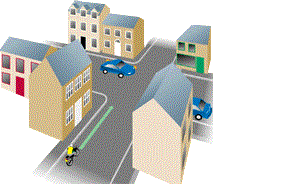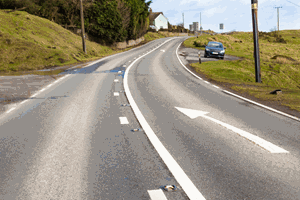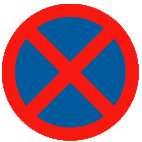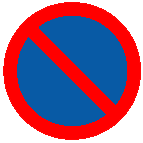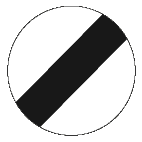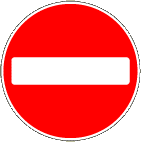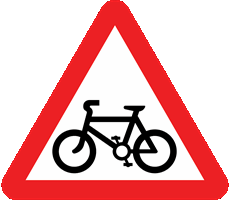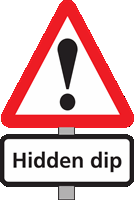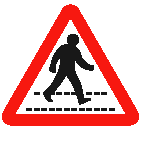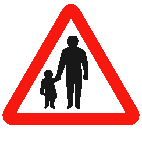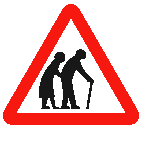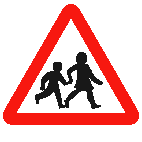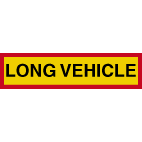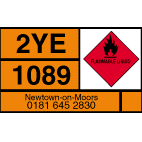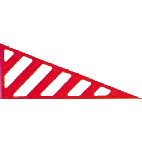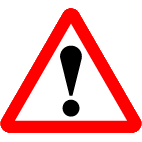You have 57 minutes to answer 50 multiple choice motorcycle theory test questions. You need to score at least 86% (43 out of 50) to pass the test. Answers may be checked after each question by clicking the 'check answer' button or you can wait until the end of the test to review your final score. Best of luck!
Test Quick View
Click on an answer to view the correct choice along with the explanation.
1. What's the most important reason why you should keep your motorcycle regularly maintained?
Mark one answer
B
C
D
Correct Answer: D
Explanation: Whenever you use any motorcycle on the road, it must be in a roadworthy condition. Regular maintenance should identify any faults at an early stage and help prevent more serious problems.
Explanation: Whenever you use any motorcycle on the road, it must be in a roadworthy condition. Regular maintenance should identify any faults at an early stage and help prevent more serious problems.
2. You're riding on a country lane. What should you do if you come across cattle on the road?
Mark one answer
B
C
D
Correct Answer: A
Explanation: Try not to startle the animals. They can be easily frightened by noise or by traffic passing too closely. Slow down, give them plenty of room and be prepared to stop if necessary. Obey any directions given by people in charge of the animals.
Explanation: Try not to startle the animals. They can be easily frightened by noise or by traffic passing too closely. Slow down, give them plenty of room and be prepared to stop if necessary. Obey any directions given by people in charge of the animals.
Correct Answer: B
Explanation: Look out for road signs warning of side roads, even if you aren't turning off. A driver who's emerging may not be able to see you due to parked cars or heavy traffic. Slow down and be prepared to stop if necessary. Remember, no-one has priority at an unmarked crossroads.
Explanation: Look out for road signs warning of side roads, even if you aren't turning off. A driver who's emerging may not be able to see you due to parked cars or heavy traffic. Slow down and be prepared to stop if necessary. Remember, no-one has priority at an unmarked crossroads.
B
C
D
Correct Answer: A
Explanation: When you get onto a motorcycle, you should get on from the left side to avoid putting yourself in danger from passing traffic. You should also apply the front brake to prevent the motorcycle from rolling either forwards or backwards.
Explanation: When you get onto a motorcycle, you should get on from the left side to avoid putting yourself in danger from passing traffic. You should also apply the front brake to prevent the motorcycle from rolling either forwards or backwards.
5. You're riding in town at night. The roads are wet after rain. How will the reflections from wet surfaces affect you?
Mark one answer
B
C
D
Correct Answer: D
Explanation: After rain, the reflections from wet surfaces will make it hard to see unlit objects. Make sure that your visor or goggles are clean, so your vision is as clear as possible. Pedestrians will be difficult to see, especially if they're wearing dark clothing.
Explanation: After rain, the reflections from wet surfaces will make it hard to see unlit objects. Make sure that your visor or goggles are clean, so your vision is as clear as possible. Pedestrians will be difficult to see, especially if they're wearing dark clothing.
Correct Answer: C
Explanation: It can be difficult to keep warm when riding a motorcycle. It's well worth buying good-quality motorcycle clothing, which will help to keep you warm and is essential for your safety. If you become very cold while riding, you'll find it difficult to concentrate on the road.
Explanation: It can be difficult to keep warm when riding a motorcycle. It's well worth buying good-quality motorcycle clothing, which will help to keep you warm and is essential for your safety. If you become very cold while riding, you'll find it difficult to concentrate on the road.
7. You're riding at night and are dazzled by the lights of an approaching vehicle. What should you do?
Mark one answer
B
C
D
Correct Answer: B
Explanation: If your view of the road ahead is restricted because you're being dazzled by approaching headlights, slow down and, if you need to, pull over and stop.
Explanation: If your view of the road ahead is restricted because you're being dazzled by approaching headlights, slow down and, if you need to, pull over and stop.
8. Your motorcycle doesn't have linked brakes. In an emergency, what should you do to stop quickly?
Mark one answer
B
C
D
Correct Answer: A
Explanation: You should plan ahead to avoid the need to stop suddenly, but if an emergency arises, you must be able to stop safely. Applying the front brake just before the rear brake will help you to stop safely and quickly.
Explanation: You should plan ahead to avoid the need to stop suddenly, but if an emergency arises, you must be able to stop safely. Applying the front brake just before the rear brake will help you to stop safely and quickly.
Correct Answer: C
Explanation: Your headlights must be properly adjusted to avoid dazzling other road users. You'll probably need to do this when carrying a heavy load or the extra weight of a pillion passenger. You may also need to adjust the tyre pressures and the suspension.
Explanation: Your headlights must be properly adjusted to avoid dazzling other road users. You'll probably need to do this when carrying a heavy load or the extra weight of a pillion passenger. You may also need to adjust the tyre pressures and the suspension.
B
C
D
Correct Answer: B
Explanation: Some road surfaces can affect the stability of a motorcycle far more than they affect other vehicles. Look out for loose or slippery road surfaces and be aware of any traffic around you. You may need to take avoiding action and change direction quickly.
Explanation: Some road surfaces can affect the stability of a motorcycle far more than they affect other vehicles. Look out for loose or slippery road surfaces and be aware of any traffic around you. You may need to take avoiding action and change direction quickly.
Correct Answer: C
Explanation: You mustn't stop on the hard shoulder, except in an emergency. Never use the hard shoulder to have a rest or a picnic, answer a mobile phone or check a road map. Also, you mustn't travel back along the hard shoulder if you've gone past your exit.
Explanation: You mustn't stop on the hard shoulder, except in an emergency. Never use the hard shoulder to have a rest or a picnic, answer a mobile phone or check a road map. Also, you mustn't travel back along the hard shoulder if you've gone past your exit.
12. Where should you take particular care to look out for other motorcyclists and cyclists?
Mark one answer
B
C
D
Correct Answer: A
Explanation: Other motorcyclists and cyclists may be difficult to see on the road, particularly at junctions. If your view is blocked by other traffic, you may not be able to see them approaching.
Explanation: Other motorcyclists and cyclists may be difficult to see on the road, particularly at junctions. If your view is blocked by other traffic, you may not be able to see them approaching.
Correct Answer: C
Explanation: Always check the rear wheel alignment after adjusting the final drive chain. Marks on the chain adjuster may be provided to make this easy. Incorrect alignment can cause instability and increased tyre wear.
Explanation: Always check the rear wheel alignment after adjusting the final drive chain. Marks on the chain adjuster may be provided to make this easy. Incorrect alignment can cause instability and increased tyre wear.
14. You've adjusted your drive chain. If this isn't done properly, what problem could it cause?
Mark one answer
B
C
D
Correct Answer: C
Explanation: After carrying out drive-chain adjustment, you should always check the rear wheel alignment. Many motorcycles have alignment guides stamped onto the frame to help you do this correctly.
Explanation: After carrying out drive-chain adjustment, you should always check the rear wheel alignment. Many motorcycles have alignment guides stamped onto the frame to help you do this correctly.
15. You need to put air into your tyres. How would you find out the correct pressure to use?
Mark one answer
B
C
D
Correct Answer: B
Explanation: Tyre pressures should be checked regularly. Look in your vehicle handbook for the correct pressures to use.
Explanation: Tyre pressures should be checked regularly. Look in your vehicle handbook for the correct pressures to use.
16. You're carrying a pillion passenger. What should you adjust to allow for the extra weight?
Mark one answer
B
C
D
Correct Answer: D
Explanation: When carrying a passenger or other extra weight, you may need to make adjustments, particularly to the rear shock absorber(s), tyre pressures and headlight alignment. Check your vehicle handbook for details.
Explanation: When carrying a passenger or other extra weight, you may need to make adjustments, particularly to the rear shock absorber(s), tyre pressures and headlight alignment. Check your vehicle handbook for details.
B
C
D
Correct Answer: B
Explanation: Take a check over your shoulder before committing yourself to a manoeuvre. This is especially important when turning right, as other road users may not have seen your signal or may not understand your intentions.
Explanation: Take a check over your shoulder before committing yourself to a manoeuvre. This is especially important when turning right, as other road users may not have seen your signal or may not understand your intentions.
Correct Answer: B
Explanation: The fuel in your motorcycle can be a dangerous fire hazard. Don't use a naked flame if you can smell fuel, and don't smoke when refuelling.
Explanation: The fuel in your motorcycle can be a dangerous fire hazard. Don't use a naked flame if you can smell fuel, and don't smoke when refuelling.
19. You're turning right onto a dual carriageway. What should you do before emerging?
Mark one answer
B
C
D
Correct Answer: B
Explanation: Before emerging right onto a dual carriageway, make sure that the central reservation is wide enough to protect your vehicle. If it isn't, you should treat it as one road and check that it's clear in both directions before pulling out.
Explanation: Before emerging right onto a dual carriageway, make sure that the central reservation is wide enough to protect your vehicle. If it isn't, you should treat it as one road and check that it's clear in both directions before pulling out.
Correct Answer: C
Explanation: Wearing bright or fluorescent clothes will help other road users to see you. Wearing a light or brightly coloured helmet can also make you more visible.
Explanation: Wearing bright or fluorescent clothes will help other road users to see you. Wearing a light or brightly coloured helmet can also make you more visible.
B
C
D
Correct Answer: A
Explanation: Drive chains wear and need frequent adjustment and lubrication. If the drive chain is worn or slack, it can jump off the sprocket and lock the rear wheel. When you've adjusted the chain tension, you need to check the rear wheel alignment. Marks by the chain adjusters may be provided to make this easier.
Explanation: Drive chains wear and need frequent adjustment and lubrication. If the drive chain is worn or slack, it can jump off the sprocket and lock the rear wheel. When you've adjusted the chain tension, you need to check the rear wheel alignment. Marks by the chain adjusters may be provided to make this easier.
22. You're riding at 70 mph on a three-lane motorway. There's no traffic ahead. Which lane should you use?
Mark one answer
B
C
D
Correct Answer: B
Explanation: Use the left-hand lane if it's free, regardless of the speed at which you're travelling.
Explanation: Use the left-hand lane if it's free, regardless of the speed at which you're travelling.
Correct Answer: C
Explanation: You don't have to ride at the speed limit. Use your own judgement and ride at a speed that suits the prevailing road, weather and traffic conditions.
Explanation: You don't have to ride at the speed limit. Use your own judgement and ride at a speed that suits the prevailing road, weather and traffic conditions.
24. You're riding on a motorway. Unless signs show otherwise, what's the national speed limit?
Mark one answer
B
C
D
Correct Answer: C
Explanation: The national speed limit of 70 mph applies to cars and motorcycles on the motorway, unless they're towing a trailer. On smart motorways, this speed limit can be reduced and overhead signs will show the new limit in force.
Explanation: The national speed limit of 70 mph applies to cars and motorcycles on the motorway, unless they're towing a trailer. On smart motorways, this speed limit can be reduced and overhead signs will show the new limit in force.
25. You're involved in a collision with another vehicle. Someone is injured and your motorcycle is damaged. What should you find out?
Mark one answer
B
C
D
Correct Answer: B
Explanation: If you're involved in a collision where someone is injured, your first priority is to warn other traffic and call the emergency services. Make sure you have all the information you need before you leave the scene - such as the other driver's name, phone number and insurance details. Don't ride your motorcycle if it's unroadworthy.
Explanation: If you're involved in a collision where someone is injured, your first priority is to warn other traffic and call the emergency services. Make sure you have all the information you need before you leave the scene - such as the other driver's name, phone number and insurance details. Don't ride your motorcycle if it's unroadworthy.
Correct Answer: B
Explanation: In this picture, the road marking shows that overtaking drivers or riders need to return to the left before they reach the hatch markings ahead. The hatch markings are designed to separate opposing streams of traffic; for example, approaching some junctions or dual carriageways.
Explanation: In this picture, the road marking shows that overtaking drivers or riders need to return to the left before they reach the hatch markings ahead. The hatch markings are designed to separate opposing streams of traffic; for example, approaching some junctions or dual carriageways.
Correct Answer: D
Explanation: Travelling at the national speed limit doesn't allow you to hog the right-hand lane. Always use the left-hand lane whenever possible. When leaving a motorway, get into the left-hand lane well before your exit. Reduce your speed on the slip road and look out for sharp bends or curves and traffic queuing at roundabouts.
Explanation: Travelling at the national speed limit doesn't allow you to hog the right-hand lane. Always use the left-hand lane whenever possible. When leaving a motorway, get into the left-hand lane well before your exit. Reduce your speed on the slip road and look out for sharp bends or curves and traffic queuing at roundabouts.
Correct Answer: D
Explanation: Look for and obey traffic signs. Disobeying or not seeing a sign could be dangerous. It may also be an offence for which you could be prosecuted.
Explanation: Look for and obey traffic signs. Disobeying or not seeing a sign could be dangerous. It may also be an offence for which you could be prosecuted.
Correct Answer: B
Explanation: Where there's a cycle route ahead, a sign will show a bicycle in a red warning triangle. Watch out for children on bicycles and cyclists rejoining the main road.
Explanation: Where there's a cycle route ahead, a sign will show a bicycle in a red warning triangle. Watch out for children on bicycles and cyclists rejoining the main road.
Correct Answer: D
Explanation: A warning sign with a picture of a windsock indicates that there may be strong side winds. This sign is often found on exposed roads.
Explanation: A warning sign with a picture of a windsock indicates that there may be strong side winds. This sign is often found on exposed roads.
Correct Answer: A
Explanation: You won't be able to see any hazards that might be hidden in the dip. As well as oncoming traffic, the dip may conceal
Explanation: You won't be able to see any hazards that might be hidden in the dip. As well as oncoming traffic, the dip may conceal
- cyclists
- horse riders
- parked vehicles
- pedestrians
32. You're approaching a junction where the traffic lights aren't working. What should you do when a police officer gives this signal?
Mark one answer

B
C
D
Correct Answer: B
Explanation: When a police officer or traffic warden is directing traffic, you must obey them. They'll use the arm signals shown in The Highway Code. Learn what these signals mean and obey them.
Explanation: When a police officer or traffic warden is directing traffic, you must obey them. They'll use the arm signals shown in The Highway Code. Learn what these signals mean and obey them.
33. You're on a three-lane motorway. There are red reflective studs on your left and white ones to your right. Which lane are you in?
Mark one answer
B
C
D
Correct Answer: A
Explanation: The colours of the reflective studs on the motorway and their locations are
Explanation: The colours of the reflective studs on the motorway and their locations are
- red - between the hard shoulder and the carriageway
- white - between lanes
- amber - between the carriageway and the central reservation
- green - along slip-road exits and entrances
- bright green/yellow - at roadworks and contraflow systems
Correct Answer: C
Explanation: Take care if you have to pass a parked vehicle on your side of the road. Give way to oncoming traffic if there isn't enough room for you both to continue safely.
Explanation: Take care if you have to pass a parked vehicle on your side of the road. Give way to oncoming traffic if there isn't enough room for you both to continue safely.
35. You've just gone through deep water. What should you do to make sure your brakes are working properly?
Mark one answer
B
C
D
Correct Answer: C
Explanation: Water on the brakes will act as a lubricant, causing them to work less efficiently. Using the brakes lightly as you go along will quickly dry them out.
Explanation: Water on the brakes will act as a lubricant, causing them to work less efficiently. Using the brakes lightly as you go along will quickly dry them out.
Correct Answer: D
Explanation: The blue-and-red circular sign on its own means that waiting restrictions are in force. This sign shows that you're leaving the controlled zone and waiting restrictions no longer apply.
Explanation: The blue-and-red circular sign on its own means that waiting restrictions are in force. This sign shows that you're leaving the controlled zone and waiting restrictions no longer apply.
37. Some two-way roads are divided into three lanes. Why are these particularly dangerous?
Mark one answer
B
C
D
Correct Answer: C
Explanation: If you intend to overtake, you must consider that approaching traffic could be planning the same manoeuvre. When you've considered the situation and decided it's safe, indicate your intentions early. This will show the approaching traffic that you intend to pull out.
Explanation: If you intend to overtake, you must consider that approaching traffic could be planning the same manoeuvre. When you've considered the situation and decided it's safe, indicate your intentions early. This will show the approaching traffic that you intend to pull out.
Correct Answer: A
Explanation: If you want to keep a vehicle untaxed and off the public road, you must make a SORN. It's an offence not to do so. Your SORN is valid until your vehicle is taxed, sold or scrapped.
Explanation: If you want to keep a vehicle untaxed and off the public road, you must make a SORN. It's an offence not to do so. Your SORN is valid until your vehicle is taxed, sold or scrapped.
Correct Answer: C
Explanation: Smart motorway schemes are intended to reduce congestion and make journey times more reliable. In these areas, the hard shoulder may be used as a running lane to ease congestion at peak times or in the event of an incident. Variable speed limits are used to help keep the traffic moving and to avoid bunching.
Explanation: Smart motorway schemes are intended to reduce congestion and make journey times more reliable. In these areas, the hard shoulder may be used as a running lane to ease congestion at peak times or in the event of an incident. Variable speed limits are used to help keep the traffic moving and to avoid bunching.
B
C
D
Correct Answer: C
Explanation: Planning your journey before you set out can help to make it much easier and more pleasant, and may help to ease traffic congestion. Look at a map to help you do this. You may need maps of different scales, depending on where and how far you're going. Printing or writing out the route can also help.
Explanation: Planning your journey before you set out can help to make it much easier and more pleasant, and may help to ease traffic congestion. Look at a map to help you do this. You may need maps of different scales, depending on where and how far you're going. Printing or writing out the route can also help.
Correct Answer: A
Explanation: Driving without insurance is a serious offence. As well as an unlimited fine, you may be disqualified or incur penalty points.
Explanation: Driving without insurance is a serious offence. As well as an unlimited fine, you may be disqualified or incur penalty points.
Correct Answer: B
Explanation: Police officers may need to direct traffic; for example, at a junction where the traffic lights have broken down. Check your copy of The Highway Code for the signals that they use.
Explanation: Police officers may need to direct traffic; for example, at a junction where the traffic lights have broken down. Check your copy of The Highway Code for the signals that they use.
43. You arrive at the scene of a crash. Someone is bleeding badly from an arm wound. Nothing is embedded in it. What should you do?
Mark one answer
B
C
D
Correct Answer: B
Explanation: If possible, lay the casualty down. Check for anything that may be in the wound. Apply firm pressure to the wound using clean material, without pressing on anything that might be in it. Raising the arm above the level of the heart will also help to stem the flow of blood.
Explanation: If possible, lay the casualty down. Check for anything that may be in the wound. Apply firm pressure to the wound using clean material, without pressing on anything that might be in it. Raising the arm above the level of the heart will also help to stem the flow of blood.
Correct Answer: D
Explanation: You can renew your vehicle tax online, at post offices and vehicle registration offices, or by phone. When applying, make sure you have all the relevant valid documents, including a valid MOT test certificate where applicable.
Explanation: You can renew your vehicle tax online, at post offices and vehicle registration offices, or by phone. When applying, make sure you have all the relevant valid documents, including a valid MOT test certificate where applicable.
Correct Answer: A
Explanation: Look well ahead and check the pavements and surrounding areas for pedestrians. Look for anyone walking towards the crossing. Check your mirrors for traffic behind, in case you have to slow down or stop.
Explanation: Look well ahead and check the pavements and surrounding areas for pedestrians. Look for anyone walking towards the crossing. Check your mirrors for traffic behind, in case you have to slow down or stop.
B
C
D
Correct Answer: D
Explanation: An adult casualty isn't breathing normally. To maintain circulation, place two hands on the centre of the chest. Then press down hard and fast - around 5-6 centimetres and about twice a second.
Explanation: An adult casualty isn't breathing normally. To maintain circulation, place two hands on the centre of the chest. Then press down hard and fast - around 5-6 centimetres and about twice a second.
47. At an incident, a small child isn't breathing. To restore normal breathing, how should you breathe into their mouth?
Mark one answer
B
C
D
Correct Answer: A
Explanation: If a young child has stopped breathing, first check that their airway is clear. Then give compressions to the chest using one hand (two fingers for an infant) and begin mouth-to-mouth resuscitation. Breathe very gently and continue the procedure until they can breathe without help.
Explanation: If a young child has stopped breathing, first check that their airway is clear. Then give compressions to the chest using one hand (two fingers for an infant) and begin mouth-to-mouth resuscitation. Breathe very gently and continue the procedure until they can breathe without help.
48. At an incident, a casualty isn't breathing. What should you do while helping them to start breathing again?
Mark one answer
B
C
D
Correct Answer: D
Explanation: It's important to ensure that the airways are clear before you start mouth-to-mouth resuscitation. Gently tilt their head back and use your finger to check for and remove any obvious obstruction in the mouth.
Explanation: It's important to ensure that the airways are clear before you start mouth-to-mouth resuscitation. Gently tilt their head back and use your finger to check for and remove any obvious obstruction in the mouth.
49. A tanker is involved in a collision. Which sign shows that it's carrying dangerous goods?
Mark one answer
B
C
D
Correct Answer: B
Explanation: There will be an orange label on the side and rear of the tanker. Look at this carefully and report what it says when you phone the emergency services. Details of hazard warning plates are given in The Highway Code.
Explanation: There will be an orange label on the side and rear of the tanker. Look at this carefully and report what it says when you phone the emergency services. Details of hazard warning plates are given in The Highway Code.
B
C
D
Correct Answer: C
Explanation: When someone is injured, any movement that isn't absolutely necessary should be avoided, since it could make the injuries worse. Unless it's essential to remove a motorcyclist's helmet, it's generally safer to leave it in place.
Explanation: When someone is injured, any movement that isn't absolutely necessary should be avoided, since it could make the injuries worse. Unless it's essential to remove a motorcyclist's helmet, it's generally safer to leave it in place.



